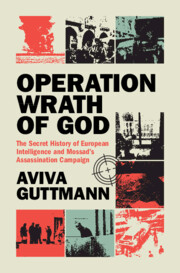 Operation Wrath of God
Operation Wrath of God Book contents
- Operation Wrath of God
- Operation Wrath of God
- Copyright page
- Dedication
- Contents
- Timeline of Main Events
- Acronyms
- Introduction: Intelligence that Kills
- Part I Preparing for God’s Wrath
- Part II Europe’s Covert War against the Palestinian Armed Struggle
- Part III Blunder and Cooperate
- Acknowledgements
- Notes
- Bibliography
- Index
Introduction: Intelligence that Kills
Published online by Cambridge University Press: 12 August 2025
- Operation Wrath of God
- Operation Wrath of God
- Copyright page
- Dedication
- Contents
- Timeline of Main Events
- Acronyms
- Introduction: Intelligence that Kills
- Part I Preparing for God’s Wrath
- Part II Europe’s Covert War against the Palestinian Armed Struggle
- Part III Blunder and Cooperate
- Acknowledgements
- Notes
- Bibliography
- Index
Summary
The introduction provides an overview of the book, presents the core arguments, highlights the contribution to current literature, explains the book’s methods and sources, and outlines the structure of the book. The overarching argument of the book is that intelligence cooperation was so beneficial for all parties that European authorities therefore let Mossad carry out its operation and tolerated the use of its intelligence to kill Palestinians. Hence, the book demonstrates that the extensive advantages that European agencies gained through Club de Berne intelligence-sharing led them to turn a blind eye towards, or even tacitly support, Israeli covert actions on their respective territories.
Keywords
Information
- Type
- Chapter
- Information
- Operation Wrath of GodThe Secret History of European Intelligence and Mossad's Assassination Campaign, pp. 1 - 14Publisher: Cambridge University PressPrint publication year: 2025
Accessibility standard: WCAG 2.0 AA
Why this information is here
This section outlines the accessibility features of this content - including support for screen readers, full keyboard navigation and high-contrast display options. This may not be relevant for you.Accessibility Information
Content Navigation
Allows you to navigate directly to chapters, sections, or non‐text items through a linked table of contents, reducing the need for extensive scrolling.
Provides an interactive index, letting you go straight to where a term or subject appears in the text without manual searching.
Reading Order & Textual Equivalents
You will encounter all content (including footnotes, captions, etc.) in a clear, sequential flow, making it easier to follow with assistive tools like screen readers.
You get concise descriptions (for images, charts, or media clips), ensuring you do not miss crucial information when visual or audio elements are not accessible.
Structural and Technical Features
You gain clarity from ARIA (Accessible Rich Internet Applications) roles and attributes, as they help assistive technologies interpret how each part of the content functions.